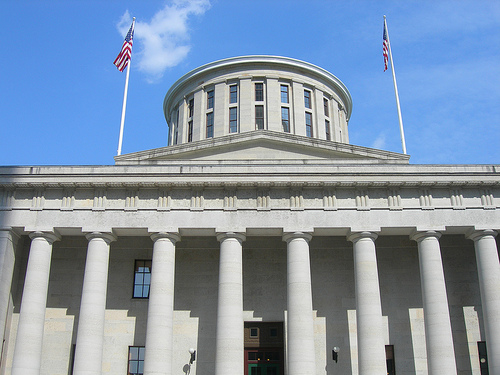One of Ohio’s largest electric utilities wants lawmakers to suspend the state’s landmark 2008 energy efficiency law during the upcoming lame duck legislative session.
FirstEnergy has been shopping a proposal to lawmakers in recent weeks that would freeze Ohio’s mandatory energy efficiency goals for utilities at current levels.
“We’re concerned whether these goals can be achieved, and whether they can be achieved economically,” FirstEnergy spokesman Doug Colafella said.
Colafella said the company did not yet have a sponsor for the legislation and that it’s merely “having conversations” in Columbus about the efficiency standard.
That hasn’t stopped a coalition of consumer, environmental and business groups from mobilizing against the threat of a rollback.
“FirstEnergy has got an army of lobbyist and lawyers. They’ve got a lot of power in this state, so I wouldn’t put anything past them,” said Dan Sawmiller, a senior campaign representative for the Sierra Club’s Beyond Coal campaign in Ohio and Kentucky.
Investing in efficiency
Ohio’s efficiency portfolio standard was created as part of a broad, bipartisan energy bill passed nearly unanimously by the legislature just four years ago.
Under the law, utilities need to help their customers conserve enough energy each year to equal a percentage of the company’s electricity sales. In 2009, the first year the standard took effect, the target was 0.3 percent of sales. After 2018, the requirement will be 2 percent of sales.
To meet the goals, utilities are spending hundreds of millions of dollars on rebates and other programs to help homeowners and businesses upgrade to more efficient light bulbs, appliances and industrial equipment.
Customers ultimately pay for those programs through a surcharge on their electricity bills, but because energy efficiency is far cheaper than building new power plants and transmission lines, consumer and environmental advocates say the investments are saving money in the long run.
In fact, that’s in the law. Utilities need to demonstrate that every dollar spent on conservation programs will produce at least a dollar in benefits to customers.
“The programs are cost-effective. What we’re really seeing in Ohio is that for every dollar customers are spending on energy efficiency, they’re saving $3,” Sawmiller said.
‘Much has changed’
FirstEnergy’s spokesman said the company agrees that energy efficiency is cheaper than building new power plants, but he said several years of flat electricity demand has led to a glut of capacity, and that it doesn’t make sense to spend customer dollars to enlarge that glut, especially given the state’s newly tapped shale gas resources.
“We just feel that much has changed since the law passed,” Colafella said.
The company is concerned, he said, that meeting higher annual targets in the years ahead will be “very expensive” and particularly burdensome for large industrial customers, some of which already pay $1 million a year in surcharges to fund efficiency programs. (A typical residential customer pays about $40 per year.)
“When you look at the price tag of these programs, particularly as the mandates become more aggressive, the question becomes: when do these programs become a drain on the economy?” Colafella said.
The proposal being circulated by FirstEnergy would indefinitely suspend the goals at half a percent of a utility’s annual sales — a milestone every utility in the state has already met. Colafella said the freeze would give officials a chance to re-evaluate and adjust the targets during next year’s regular session.
Attack on standard
Brian Kaiser, a legislative affairs associate with the Ohio Environmental Council, says it’s an attempt to gut the law under the guise of stopping to study it. And attaching it to an unrelated floor bill during a lame duck session is a tactic to avoid public hearings, he said.
The Ohio Environmental Council began hearing rumors of FirstEnergy’s proposal in late October, and in the days following the election it obtained a copy of specific language that was being circulated by the company. (Colafella declined to confirm the authenticity of the document.)
The amendments outlined in the document would cap annual benchmarks at half a percent. They would allow utilities to count efficiency gains from federal rules or codes as their own achievements. And it would terminate the entire policy upon passage of a federal efficiency standard.
“It’s going to be a significant hit to the energy efficiency industry, and it’s going to mean rate increases,” said Steve Caminati, vice president of public affairs for Advanced Energy Economy Ohio, a clean energy trade association. The group estimates about 10,000 Ohioans work in energy efficiency related jobs, many of which would be at risk without the goals.
‘The program is working as intended’
The Ohio Manufacturers Association lent its support to the efficiency standard on Friday, issuing a call to action against FirstEnergy’s proposal.
“The program is working as intended and delivering substantial documented benefits for customers,” the manufacturers association said. “Rushing to judgment on the question of retreating from or staying the course … could have dangerous consequences that put Ohio customers unnecessarily at risk.”
And another major Ohio utility, American Electric Power, also criticized FirstEnergy’s efforts to rollback the standard.
“We do not agree with their position,” AEP spokeswoman Terri Flor said. “We’ve had successful efficiency programs since the start of the standard and have continued to have success with both residential and business programs.”
That said, AEP recognizes the importance of occasionally reviewing the targets, especially as they become more aggressive.
“We need to have that discussion in an open and transparent process,” Flor said. “I don’t think this is something that just utilities can decide.”
The Sierra Club and the Ohio Environmental Council are members of RE-AMP, which also publishes Midwest Energy News. first energy

